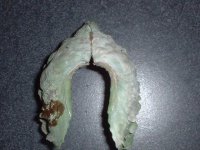Greg,GSchiemer":2i3z19ul said:You'll never see a maxima clam with the deep indentations of the shell or the large scutes that are displayed on this clam. It's distinctively squamosa. Most maxima clams are generally "straight" along the length of the shell or bulge in the middle. The shape and pattern of the mantle is also indicative of squamosa, but that's a secondary indication......
Greg
Maxima and Squamosa have the most indentations of their shells and largest scutes. Tony’s picture show nothing that one can use to differentiate the two using the shell. It is not very prominent at all IMO. The mantle coloration is too destroyed to give clear differentiation between Maxima and Squamosa. It certainly can be c/w a gold Maxima. The spots on the edge of the mantels, however, make it more likely to be Maxima.
All in all, IMO, the picture indicated that it is more likely Maxima. If Tony can give a picture of the byssus opening (bottom of the shell). This will settle it (100%).
I really don't see how one can be 100% sure that the clam pictured by Tony is a Squamosa. IMO, it is much more likely to be a Maxima.
Both of the pictures you show, the first is clearly a Squamosa. The second picture is by not a picture one can use to positively ID the clam as a Squamosa. It has very many characteristic of a larger Derasa. In fact, without knowing anything else, I would have to say that the picture shows the clam to be a Derasa instead of a Squamosa. I got one just like it.
The coloration is typical of a Derasa, the lack of extensive indentaiton of the mantle and the narrowness of the valley between the mantles indicated that this is a Derasa.
Greg, are both of the clams picture are yours clams?
Most of the clams are all pretty distinctive. However, without considering the coloration but only use the shape of the mantle, it is easy to tell a Crocea from Maxima and Squamosa because Crocea do not have the strong indentation or "pinched" as Squamosa and Maxima.And maxima clams. The shells are generally straight and the mantles are a little "pinched" along the shell. It's easy to confuse crocea and maxima clams, but squamosa clams are distinctive.
Minh







